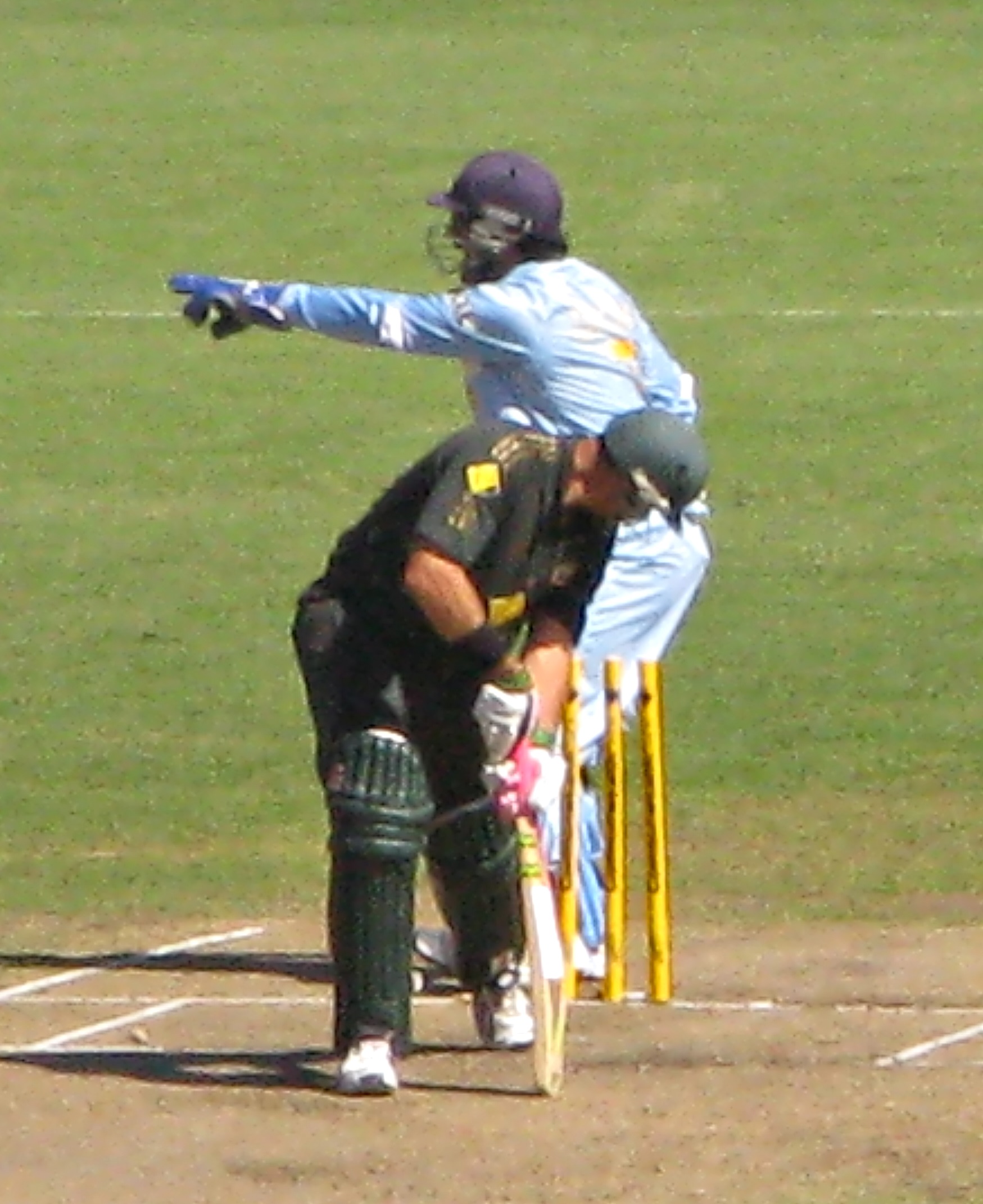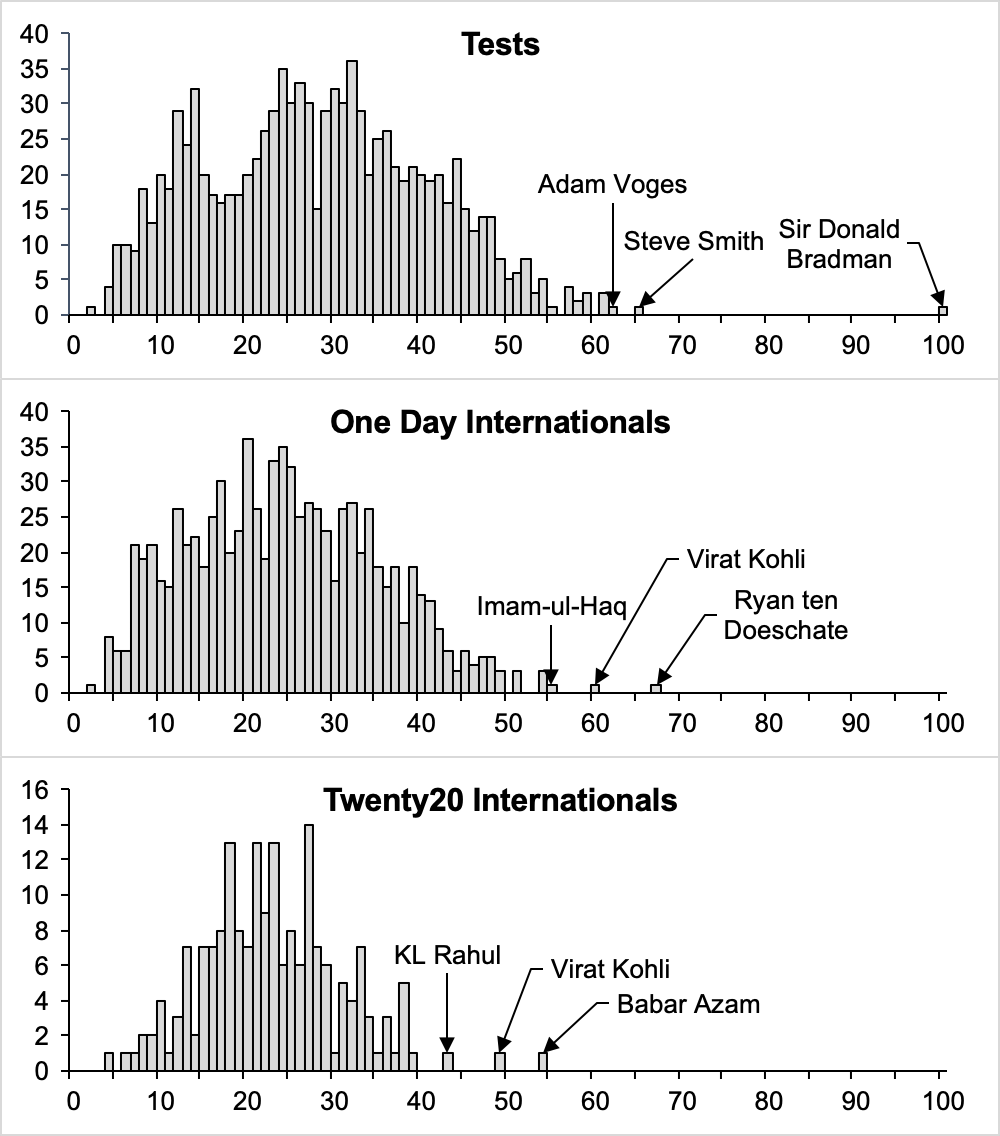|
Rodney Holmes
John Rodney Reay Holmes (24 April 1924 – 3 February 1980) was an English cricketer. Holmes was a right-handed batsman who fielded as a wicket-keeper. He was born at Hollington, Sussex, and educated at Repton School. After leaving Repton School, Holmes enlisted as a war sub in the war effort with the Rifle Brigade in 1943. In April 1944, he gained the temporary rank of Lieutenant, while following the war he was granted the full rank of 2nd Lieutenant in March 1946, with seniority back to 7 April 1945. In October 1946, Holmes was granted the rank of Lieutenant. Holmes later made his first-class debut for the Free Foresters against Oxford University in 1949. The following season he made his first-class debut for Sussex against Oxford University. The presence of Jim Parks in the Sussex squad limited Holmes to just one further first-class appearance, in 1951 against Oxford University. All three of his first-class appearances came at Oxford University's University Parks. He score ... [...More Info...] [...Related Items...] OR: [Wikipedia] [Google] [Baidu] |
Hollington, Hastings
Hollington is a council estate and local government ward in the northwest of Hastings, East Sussex. The area lies next to Baldslow, Ashdown, North and Conquest, and less than five miles southeast of Battle, East Sussex, the home of Battle Abbey, which commemorates the victory of William the Conqueror at the Battle of Hastings in 1066. The area is believed to have been occupied since at least Roman times prior to becoming farmland and subsequently developed during the 1930s onwards.Historical Hastings WikiHollington - Historical Hastings Wiki accessdate: 9 January 2020 Hollington was the location of The Grove School, which was incorporated into The St Leonards Academy becoming known as the 'Darwell Campus'. The school, which was constructed at the location of The Grove, the manor house for the Lords of the Manor of Hollington. The Levett family built The Grove, and then the property was carried into the Eversfield family by a Levett heiress. The eventual lord of the manor beca ... [...More Info...] [...Related Items...] OR: [Wikipedia] [Google] [Baidu] |
Free Foresters Cricket Club
Free Foresters Cricket Club is an English amateur cricket club, established in 1856 for players from the Midland counties of England. It is a 'wandering' (or nomadic) club, having no home ground. The Free Foresters were founded by the Rev. William Kirkpatrick Riland Bedford, who had been appointed rector of Sutton Coldfield in 1850. At Oxford University, he had discovered cricket and in 1847 he had set up the Sutton Coldfield Cricket Club. The name of the Free Foresters was chosen to reflect that archery had been popular at the Rectory Park long before cricket was introduced. The club played its first match on 20 July 1856 against the Pilgrims of the Dee, at the Rectory Ground in Sutton Coldfield. In 1863, the Free Foresters presented the rector with a silver salver as a token of their esteem. The salver can be seen at Lord's cricket ground. For many years, starting in 1912, their matches against Oxford University and Cambridge University had first-class status, the last such ... [...More Info...] [...Related Items...] OR: [Wikipedia] [Google] [Baidu] |
The Victoria Advocate
''The Victoria Advocate'' is a daily newspaper independently published in Victoria, Texas. It is the second-oldest paper in Texas and the oldest west of the Colorado River, dating back to May 8, 1846, following the Battle of Palo Alto during the Mexican War. The paper serves the communities of the Victoria metropolitan area, and currently runs a Sunday circulation of 27,268 issues. History The paper was founded in 1846 by publishers John D. Logan and Thomas Sterne of Van Buren, Arkansas, as a weekly publication named the ''Texan Advocate''. The two men had previously founded the ''Frontier Whig'' two years earlier, and like the ''Whig'', the ''Advocate'' was associated with the Whig Party during its initial stages. Famed journalist John Henry Brown was briefly employed as an editor for the paper in its first year. After the publication was renamed the ''Texian Advocate'', ownership changed hands several times during the 1850s. In 1859, it was bought by Sam Addison White, who ren ... [...More Info...] [...Related Items...] OR: [Wikipedia] [Google] [Baidu] |
Wisden Cricketers' Almanack
''Wisden Cricketers' Almanack'', or simply ''Wisden'', colloquially the Bible of Cricket, is a cricket reference book published annually in the United Kingdom. The description "bible of cricket" was first used in the 1930s by Alec Waugh in a review for the ''London Mercury''. In October 2013, an all-time Test World XI was announced to mark the 150th anniversary of ''Wisden Cricketers' Almanack''. In 1998, an Australian edition of ''Wisden Cricketers' Almanack'' was launched. It ran for eight editions. In 2012, an Indian edition of ''Wisden Cricketers' Almanack'' was launched (dated 2013), entitled ''Wisden India Almanack'', that has been edited by Suresh Menon since its inception. History ''Wisden'' was founded in 1864 by the English cricketer John Wisden (1826–84) as a competitor to Fred Lillywhite's '' The Guide to Cricketers''. Its annual publication has continued uninterrupted to the present day, making it the longest running sports annual in history. The sixth e ... [...More Info...] [...Related Items...] OR: [Wikipedia] [Google] [Baidu] |
Italy
Italy ( it, Italia ), officially the Italian Republic, ) or the Republic of Italy, is a country in Southern Europe. It is located in the middle of the Mediterranean Sea, and its territory largely coincides with the homonymous geographical region. Italy is also considered part of Western Europe, and shares land borders with France, Switzerland, Austria, Slovenia and the enclaved microstates of Vatican City and San Marino. It has a territorial exclave in Switzerland, Campione. Italy covers an area of , with a population of over 60 million. It is the third-most populous member state of the European Union, the sixth-most populous country in Europe, and the tenth-largest country in the continent by land area. Italy's capital and largest city is Rome. Italy was the native place of many civilizations such as the Italic peoples and the Etruscans, while due to its central geographic location in Southern Europe and the Mediterranean, the country has also historically been home ... [...More Info...] [...Related Items...] OR: [Wikipedia] [Google] [Baidu] |
Avalanche
An avalanche is a rapid flow of snow down a slope, such as a hill or mountain. Avalanches can be set off spontaneously, by such factors as increased precipitation or snowpack weakening, or by external means such as humans, animals, and earthquakes. Primarily composed of flowing snow and air, large avalanches have the capability to capture and move ice, rocks, and trees. Avalanches occur in two general forms, or combinations thereof: slab avalanches made of tightly packed snow, triggered by a collapse of an underlying weak snow layer, and loose snow avalanches made of looser snow. After being set off, avalanches usually accelerate rapidly and grow in mass and volume as they capture more snow. If an avalanche moves fast enough, some of the snow may mix with the air, forming a powder snow avalanche. Though they appear to share similarities, avalanches are distinct from slush flows, mudslides, rock slides, and serac collapses. They are also different from large scale movement ... [...More Info...] [...Related Items...] OR: [Wikipedia] [Google] [Baidu] |
Major (United Kingdom)
Major (Maj) is a military rank which is used by both the British Army and Royal Marines. The rank is superior to captain and subordinate to lieutenant colonel. The insignia for a major is a crown. The equivalent rank in the Royal Navy is lieutenant commander, and squadron leader in the Royal Air Force. History By the time of the Napoleonic wars, an infantry battalion usually had two majors, designated the "senior major" and the "junior major". The senior major effectively acted as second-in-command and the majors often commanded detachments of two or more companies split from the main body. The second-in-command of a battalion or regiment is still a major. File:British-Army-Maj(1856-1867)-Collar Insignia.svg, 1856 to 1867 major's collar rank insignia File:British-Army-Maj(1867-1880)-Collar Insignia.svg, 1867 to 1880 major's collar rank insignia File:British&Empire-Army-Maj(1881-1902).svg, 1881 to 1902 major's shoulder rank insignia During World War I, majors wore the follo ... [...More Info...] [...Related Items...] OR: [Wikipedia] [Google] [Baidu] |
Captain (British Army And Royal Marines)
Captain (Capt) is a junior officer rank of the British Army and Royal Marines and in both services it ranks above lieutenant and below major with a NATO ranking code of OF-2. The rank is equivalent to a lieutenant in the Royal Navy and to a flight lieutenant in the Royal Air Force. The rank of captain in the Royal Navy is considerably more senior (equivalent to the Army/RM rank of colonel) and the two ranks should not be confused. In the 21st-century British Army, captains are often appointed to be second-in-command (2IC) of a company or equivalent sized unit of up to 120 soldiers. History A rank of second captain existed in the Ordnance at the time of the Battle of Waterloo. From 1 April 1918 to 31 July 1919, the Royal Air Force maintained the junior officer rank of captain. RAF captains had a rank insignia based on the two bands of a naval lieutenant with the addition of an eagle and crown above the bands. It was superseded by the rank of flight lieutenant on the fol ... [...More Info...] [...Related Items...] OR: [Wikipedia] [Google] [Baidu] |
Stumped
Stumped is a method of dismissing a batsman in cricket, which involves the wicket-keeper putting down the wicket while the batsman is out of his ground. (The batsman leaves his ground when he has moved down the pitch beyond the popping crease, usually in an attempt to hit the ball). The action of stumping can only be performed by a wicket-keeper, and can only occur from a legitimate delivery (i.e. not a no-ball), while the batsman is not attempting a run; it is a special case of a run out. Being "out of his ground" is defined as not having any part of the batsman's body or his bat touching the ground behind the crease – i.e., if his bat is slightly elevated from the floor despite being behind the crease, or if his foot is on the crease line itself but not completely across it and touching the ground behind it, then he would be considered out (if stumped). One of the fielding team (such as the wicket-keeper himself) must appeal for the wicket by asking the umpire. The appea ... [...More Info...] [...Related Items...] OR: [Wikipedia] [Google] [Baidu] |
Caught
Caught is a method of dismissing a batsman in cricket. A batsman is out caught if the batsman hits the ball, from a legitimate delivery, with the bat, and the ball is caught by the bowler or a fielder before it hits the ground. If the ball hits the stumps after hitting the wicket-keeper, If the wicket-keeper fails to do this, the delivery is a "no ball", and the batsman cannot be stumped (nor run out, unless he attempts to run to the other wicket.) If the catch taken by the wicket-keeper,then informally it is known as caught behind or caught at the wicket. A catch by the bowler is known as caught and bowled. This has nothing to do with the dismissal bowled but is rather a shorthand for saying the catcher and bowler are the same player. (The scorecard annotation is usually ''c. and b.'' or ''c&b'' followed by the bowler's name.) Caught is the most common method of dismissal at higher levels of competition, accounting for 36,190 Test match dismissals between 1877 and 2012, wh ... [...More Info...] [...Related Items...] OR: [Wikipedia] [Google] [Baidu] |
Stump (cricket)
In cricket, the stumps are the three vertical posts that support the bails and form the wicket. '' Stumping'' or ''being stumped'' is a method of dismissing a batsman. The umpire ''calling stumps'' means the play is over for the day. Part of the wicket The stumps are three vertical posts which support two bails. The stumps and bails are usually made of wood, most commonly ash, and together form a wicket at each end of the pitch. The overall width of each wicket is 9 inches (22.9 cm). Each stump is 28 inches (71.1 cm) tall with maximum and minimum diameters of 1 inches (3.81 cm) and 1 inches (3.49 cm). They have a spike at one end for inserting into the ground, and the other end has a U-shaped 'through groove' to provide a resting place for the bails. In junior cricket the items have lesser dimensions. Each stump is referred to by a specific name: * Off stump is the stump on the off side of the wicket (the same side as the batsman's bat). * Mid ... [...More Info...] [...Related Items...] OR: [Wikipedia] [Google] [Baidu] |
Batting Average (cricket)
In cricket, a player's batting average is the total number of runs they have scored divided by the number of times they have been out, usually given to two decimal places. Since the number of runs a player scores and how often they get out are primarily measures of their own playing ability, and largely independent of their teammates, batting average is a good metric for an individual player's skill as a batter (although the practice of drawing comparisons between players on this basis is not without criticism). The number is also simple to interpret intuitively. If all the batter's innings were completed (i.e. they were out every innings), this is the average number of runs they score per innings. If they did not complete all their innings (i.e. some innings they finished not out), this number is an estimate of the unknown average number of runs they score per innings. Each player normally has several batting averages, with a different figure calculated for each type of match ... [...More Info...] [...Related Items...] OR: [Wikipedia] [Google] [Baidu] |






